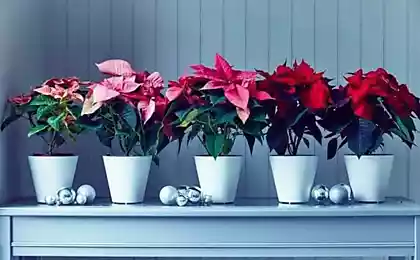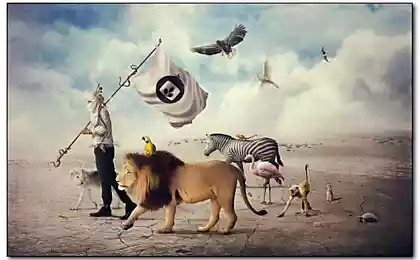636
The most dangerous plants for Your Pets
As a result of evolution not only animals acquired mechanisms of protection from natural enemies. Nature took care of the plants. Poisonous juice, rafidi (thin needle-like education, located in the intercellular space), thorns, thorns and sharp edges of the leaf blades are capable of inflicting significant harm to the health. And if people are protected by their experience and knowledge, the Pets of such protection do not have.

Home "accommodation" deprives animals of the natural instincts. And the range of many plants does not coincide with the natural habitats of cats, dogs, small rodents — the most popular residents of our apartments. And if the cases of poisoning of adult animals is quite rare, toxic shock puppies, kittens, rabbits and other "young people" are much more common. Responsibility to protect fall on the shoulders of the owners. And for that you need to know the danger "in the face".ON
Top 10 toxic plants1. Araceae
Dieffenbachia, Monstera, Spathiphyllum, Anthurium, Epipremnum, Epipremnum, Syngonium, Philodendron, Caladium, Colocasia. Their juice contains poisonous substances that protect plants from being eaten. As a result, even one bite causes burning and swelling of the mucous membranes of the larynx. In case of contact with eyes develops conjunctivitis, irreversible change in the cornea. Note that all dangerous parts of plants: leaves, stems, flowers, roots, which contain toxic proteins and cyanide compounds. Even a small dose of these substances can lead to death of the animal.
2. Euphorbiaceae
Euphorbia, Croton, Akalifa, Jatropha. The danger is the juice which can cause irritation of skin and mucous membranes. Many eaten green mass leads to burns, ulcers, inflammation of mucous membranes, violation of nervous activity and dysfunction of the gastrointestinal tract. Do not install the pots with these plants within the reach of animals: juice in the tissues of the Euphorbiaceae is under pressure and acts on the surface (and sometimes sprinkles) at the slightest damage.
3. Solanaceae
The capsicum (ornamental Pepper), Browallia, Brunfelsia, Solandra. The juice of these plants contain toxic alkaloids. The danger is compounded by the fact that the bright fruits of Solanaceae attracted attention as Pets and ornamental birds. The result of "tasting" becomes nausea, vomiting, drowsiness.
4. Dogbane
Adenium, Oleander, Mandevilla, And Catharanthus. The juice of these plants are poisonous to such an extent that in ancient times was used as a poison for the treatment of arrowheads. Breeding and domestication has led to a significant reduction of toxicity, however, the danger remained. The SAP contains cardiac glycosides. They are able to cause severe cardiac abnormalities, in severe cases lead to death of the animal.
5. Araliaceae
Header (Ivy), Polyscias, Fats. Particularly dangerous are these plants for rodents. Toxic substances contained in the leaves and stems that can cause disorders of the nervous activities until the palsy, a disorder of the cardiovascular system.
6. Amaryllidaceae
Clivia, Gippeastrum, Haemanthus. These plants are not so dangerous, but only due to the fact that the bulk of the toxic substances concentrated in the bulbs and corms. Cat or dog to get to them is not so easy, however, pet rodents may get the alkaloid poisoning. However, some of the toxins present in the juice of the green parts of plants: leaves and stems. Especially dangerous Clivia is a small amount of juice may lead to paralysis and the development of pathology of the internal organs.
7. Heather
The foliage is a bright representative of this family of Rhododendrons contain poisonous substances that can cause numbness, vomiting some Pets or excitement of others. Possible violations of functioning of cardiovascular system.
8. Mulberry
Ficus, one of the most common plants in the house. However, it should also be treated with caution: damage to the foliage stands out the juice, can cause burns to the skin and when ingested, is a kidney disease. Ficus as a bonsai can be dangerous prey for Pets
9. Sedge
Tsiperus, also common in apartments undemanding plant, like to eat off the cat. However, the juice of Cyperus can also cause disorders in the cardiovascular system, renal failure. The beginning of the seizures shows that the poisoning affected the internal organs.
10. Bezwremennika
Gloriosa — all parts of this remarkable plant contain an alkaloid called colchicine. He is able to disrupt blood clotting and cause severe kidney damage.
Symptoms otravleniya common symptoms of poisoning are nausea, vomiting, restless animal behavior: excessive excitement or, conversely, drowsiness and lethargy. The difficulty is that neither dogs nor cats are not able to tell about their problems. It is necessary to observe, speculate and draw conclusions. Therefore, if the animal's behavior does not correspond to the usual norm, it is necessary to examine house plants: there is no damage, bite marks on leaves and stems. If any discovered, the animal should render first aid and to seek emergency vet.
First aid for otravleniya types of aid have the same goal: to remove fragments of plants with skin or mucous membranes of an animal and/or to take care of the removal of toxins from the body. As the available tools used by a large amount of water. It takes a long time to wash the eyes and skin.
If the animal had swallowed a piece of the plant, need to give him to drink plenty of liquids, it is desirable to induce vomiting. Necessary and as quickly as possible should visit the vet. You need to take and a fragment of a plant so doctors can quickly determine the type of toxins.
How to prevent kontaktne wonder they say that the best medicine is prevention. If you have toxic plants, you should worry about the safety of the animals. So, for example, specifically for cats can be planted oats, wheat or grass purchased at a pet store. Animals will eat the young shoots, and thus to compensate for the deficiency of essential body substances.
As a "repeller" can be purchased the appropriate remedy. In pet stores sell compounds called "Antigryzin". They splash on the foliage, pots, and so reduce to zero culinary curiosity cat. Of popular recipes, from dangerous plant and animal life able to scare off the smell of lemons. Dried peel or saucer with lemon juice, set close to the pots, will cause the cat not to approach the dangerous plants. The same effect can be achieved with the smell of pepper or beer.
If the apartment has a dog, enough to raise plants to the height to put on top of the wardrobe or on shelves. Plants standing on the windowsill, you can block the use of blinds. The last solution is a good way with the birds outside of cages.
If the apartment contains rodents such as rabbit, rat, chinchilla, hamsters — they are best kept in a cage. Release on a walk, but only within a room where there are no dangerous types of plants.
There is another effective way to raise in the house only safe for animals. It may be Begonia, Maranta, Dracaena, Coleus, Tradescantia, Chlorophytum or Peperomiya.
Finally some tips:
Do not put the dangerous plants in the area of access to Pets. In relation to cats is the best preventive measure would be fit her "personal" green — grass make up the deficit of vitamins. At the first signs of poisoning administer first aid and take him to the vet. Bring a plant or part of it — this will help the doctor to determine the toxin and to appoint effective treatment. There are many attractive plants, completely safe for animals — pay attention to them and don't worry about their Pets.
Source: leplants.ru/interior/plants-animals/samye-opasnye-rasteniya-dlya-domashnih-zhivotnyh/

Home "accommodation" deprives animals of the natural instincts. And the range of many plants does not coincide with the natural habitats of cats, dogs, small rodents — the most popular residents of our apartments. And if the cases of poisoning of adult animals is quite rare, toxic shock puppies, kittens, rabbits and other "young people" are much more common. Responsibility to protect fall on the shoulders of the owners. And for that you need to know the danger "in the face".ON
Top 10 toxic plants1. Araceae
Dieffenbachia, Monstera, Spathiphyllum, Anthurium, Epipremnum, Epipremnum, Syngonium, Philodendron, Caladium, Colocasia. Their juice contains poisonous substances that protect plants from being eaten. As a result, even one bite causes burning and swelling of the mucous membranes of the larynx. In case of contact with eyes develops conjunctivitis, irreversible change in the cornea. Note that all dangerous parts of plants: leaves, stems, flowers, roots, which contain toxic proteins and cyanide compounds. Even a small dose of these substances can lead to death of the animal.
2. Euphorbiaceae
Euphorbia, Croton, Akalifa, Jatropha. The danger is the juice which can cause irritation of skin and mucous membranes. Many eaten green mass leads to burns, ulcers, inflammation of mucous membranes, violation of nervous activity and dysfunction of the gastrointestinal tract. Do not install the pots with these plants within the reach of animals: juice in the tissues of the Euphorbiaceae is under pressure and acts on the surface (and sometimes sprinkles) at the slightest damage.
3. Solanaceae
The capsicum (ornamental Pepper), Browallia, Brunfelsia, Solandra. The juice of these plants contain toxic alkaloids. The danger is compounded by the fact that the bright fruits of Solanaceae attracted attention as Pets and ornamental birds. The result of "tasting" becomes nausea, vomiting, drowsiness.
4. Dogbane
Adenium, Oleander, Mandevilla, And Catharanthus. The juice of these plants are poisonous to such an extent that in ancient times was used as a poison for the treatment of arrowheads. Breeding and domestication has led to a significant reduction of toxicity, however, the danger remained. The SAP contains cardiac glycosides. They are able to cause severe cardiac abnormalities, in severe cases lead to death of the animal.
5. Araliaceae
Header (Ivy), Polyscias, Fats. Particularly dangerous are these plants for rodents. Toxic substances contained in the leaves and stems that can cause disorders of the nervous activities until the palsy, a disorder of the cardiovascular system.
6. Amaryllidaceae
Clivia, Gippeastrum, Haemanthus. These plants are not so dangerous, but only due to the fact that the bulk of the toxic substances concentrated in the bulbs and corms. Cat or dog to get to them is not so easy, however, pet rodents may get the alkaloid poisoning. However, some of the toxins present in the juice of the green parts of plants: leaves and stems. Especially dangerous Clivia is a small amount of juice may lead to paralysis and the development of pathology of the internal organs.
7. Heather
The foliage is a bright representative of this family of Rhododendrons contain poisonous substances that can cause numbness, vomiting some Pets or excitement of others. Possible violations of functioning of cardiovascular system.
8. Mulberry
Ficus, one of the most common plants in the house. However, it should also be treated with caution: damage to the foliage stands out the juice, can cause burns to the skin and when ingested, is a kidney disease. Ficus as a bonsai can be dangerous prey for Pets
9. Sedge
Tsiperus, also common in apartments undemanding plant, like to eat off the cat. However, the juice of Cyperus can also cause disorders in the cardiovascular system, renal failure. The beginning of the seizures shows that the poisoning affected the internal organs.
10. Bezwremennika
Gloriosa — all parts of this remarkable plant contain an alkaloid called colchicine. He is able to disrupt blood clotting and cause severe kidney damage.
Symptoms otravleniya common symptoms of poisoning are nausea, vomiting, restless animal behavior: excessive excitement or, conversely, drowsiness and lethargy. The difficulty is that neither dogs nor cats are not able to tell about their problems. It is necessary to observe, speculate and draw conclusions. Therefore, if the animal's behavior does not correspond to the usual norm, it is necessary to examine house plants: there is no damage, bite marks on leaves and stems. If any discovered, the animal should render first aid and to seek emergency vet.
First aid for otravleniya types of aid have the same goal: to remove fragments of plants with skin or mucous membranes of an animal and/or to take care of the removal of toxins from the body. As the available tools used by a large amount of water. It takes a long time to wash the eyes and skin.
If the animal had swallowed a piece of the plant, need to give him to drink plenty of liquids, it is desirable to induce vomiting. Necessary and as quickly as possible should visit the vet. You need to take and a fragment of a plant so doctors can quickly determine the type of toxins.
How to prevent kontaktne wonder they say that the best medicine is prevention. If you have toxic plants, you should worry about the safety of the animals. So, for example, specifically for cats can be planted oats, wheat or grass purchased at a pet store. Animals will eat the young shoots, and thus to compensate for the deficiency of essential body substances.
As a "repeller" can be purchased the appropriate remedy. In pet stores sell compounds called "Antigryzin". They splash on the foliage, pots, and so reduce to zero culinary curiosity cat. Of popular recipes, from dangerous plant and animal life able to scare off the smell of lemons. Dried peel or saucer with lemon juice, set close to the pots, will cause the cat not to approach the dangerous plants. The same effect can be achieved with the smell of pepper or beer.
If the apartment has a dog, enough to raise plants to the height to put on top of the wardrobe or on shelves. Plants standing on the windowsill, you can block the use of blinds. The last solution is a good way with the birds outside of cages.
If the apartment contains rodents such as rabbit, rat, chinchilla, hamsters — they are best kept in a cage. Release on a walk, but only within a room where there are no dangerous types of plants.
There is another effective way to raise in the house only safe for animals. It may be Begonia, Maranta, Dracaena, Coleus, Tradescantia, Chlorophytum or Peperomiya.
Finally some tips:
Do not put the dangerous plants in the area of access to Pets. In relation to cats is the best preventive measure would be fit her "personal" green — grass make up the deficit of vitamins. At the first signs of poisoning administer first aid and take him to the vet. Bring a plant or part of it — this will help the doctor to determine the toxin and to appoint effective treatment. There are many attractive plants, completely safe for animals — pay attention to them and don't worry about their Pets.
Source: leplants.ru/interior/plants-animals/samye-opasnye-rasteniya-dlya-domashnih-zhivotnyh/
Mystery bright spots on the surface of the dwarf planet Ceres continues
Karma of the brain: are we condemned to live in illusion?






















